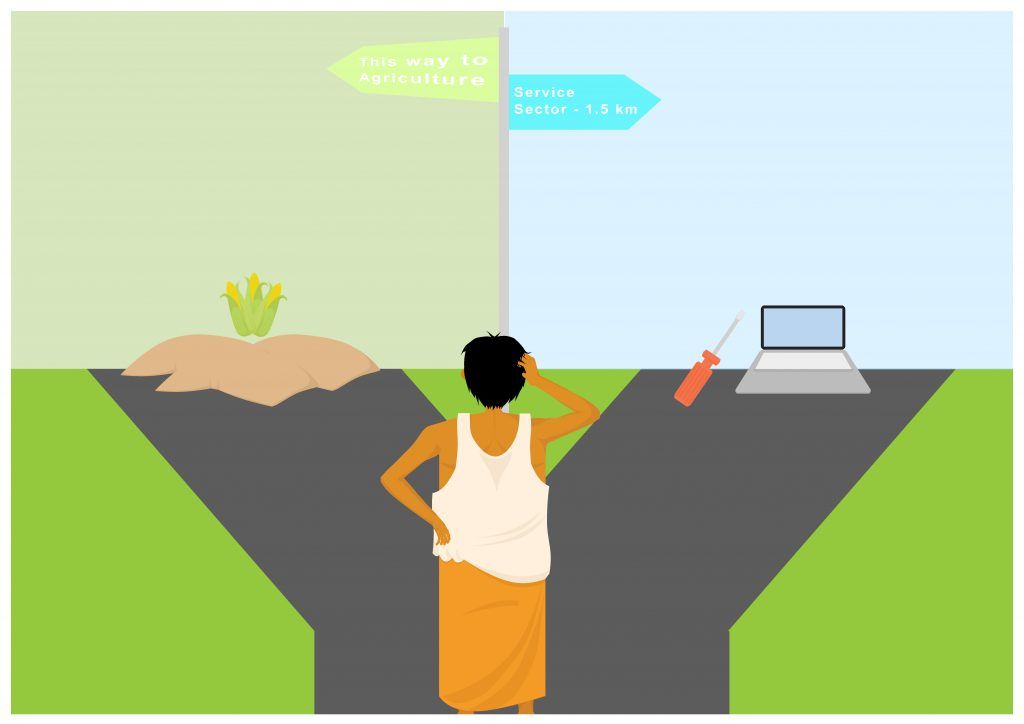India is an agrarian country and the World Economic Forum estimates over 55 per cent of the rural population of the country make a living from this sector. What is astounding however is that this 55 per cent of the population is employed in agriculture and its allied industries but the amount generated from this segment is only 17 per cent of the Gross Domestic Product (GDP) of the country.
The main source of national income comes from the services industries which generates 55.65 per cent of the GDP of India. The number of people employed in the services sector is a low 28.6 per cent of the population. Now think about it ̶ 28.8 per cent of the entire population account for 55.65 per cent of the country’s GDP whilst the sector that employs the most number of people accounts for just 17 per cent and this number has also been steadily declining. This does not add up. There is also continual focus being put on agriculture rather than focusing on other sectors which are more productive.
In the services sector, the IT industry is the largest private-sector employee. The government has eased trading barriers and restrictions in the services sector which has benefited the industry. The services sector has received the most Foreign Direct Investment (FDI) inflow between 2000 and June 2018 which has totalled to a whopping US$ 68.62 billion. There are also plans by the government to table a draft legal text on Trade Facilitation in Services to the WTO.

A report by Hindu Business Line stated growing concerns of children of farmers moving away from agriculture and the family occupation. To address this issue, the government has started the Attraction and Retaining Youth in Agriculture (ARYA) programme which aims to offer bankable options for the youth in agriculture and allied services. The ARYA programme is however innovative in some ways. Deputy Director-General of Indian Council of Agricultural Research (ICAR) AK Singh in an interview to Business Line stated, “We are trying to create a model to make the youth stay in agriculture, which can then be replicated elsewhere. We have identified certain areas. For example, for bee-keeping and growing mushrooms, you don’t need much land.”
These steps of including measures for landless farmers are a definite plus point but do not offer a permanent solution as there is an overwhelming number of farmers in the country.
India’s arable land area of 394.6 million acres is the second largest in the world, after the United States. There has been robust development in the agricultural sector in India in terms of production but despite this, Indian farmers are going through financial distress and insecurities. This has led to a spate of farmer suicides across the country.
In 2014, the National Crime Records Bureau of India reported 5,650 farmer suicides. The highest number of farmer suicides was recorded in 2004 when 18,241 farmers committed suicide. A report by the state government of Maharashtra showed that in 2018, 639 farmers committed suicide between March 1 and May 31 in the state.
Despite India being an agrarian economy, farmers face a number of challenges- high levels of illiteracy, limited access to resources and lack of healthcare facilities are major concerns. Droughts, low quality input, difficult access to institutional credit, poor market infrastructure and policy paralysis also add to farmer woes.

The Indian government for the past few decades has been implementing the policy of hoarding grains. This is mainly due to concerns over food security issues which are the after-effects of the 1960’s epidemic where there was shortage of grains which led to millions of Indians going hungry. But times are different now and the focus should be on saving water. The main crops grown in India are rice, wheat, maize, sugarcane and cotton. All five use large amounts of water and data analysis conducted by Roshan Kishore for Live Mint showed the average water footprint of these crops to be far higher than global averages. What can also be noted is India’s reluctance to increase production of pulses. Incidentally, countries like Canada export protein rich pulses to meet the deficit amount needed by India. If India wants to continue putting its efforts mainly on agriculture, there should be a gradual shift to growing protein and micro nutrient rich foods so as to reach the country’s food requirements and be less dependent on imports.
India is an anomaly in that it shifted from the agricultural sector directly into the services sector whilst bypassing the industrial phase. This is an economic achievement with the IT sector at its heart.
IT and its allied sectors have low cost manpower and there is a large youthful population looking to move away from agriculture. The IT sector is a better option for the government to bank upon. The key driver in India’s economic growth has been the services sector which includes activities ranging from real estate, hotels and restaurants, transport, finance and all the way up to social and personal services. These are just a few and the allied services which come along, are aplenty. The services sector also has potential to create jobs and hence can be a solution to the mass unemployment faced by the youth in the country.
However, Indian cities are overcrowded and to accommodate the new workforce would require urbanization. Successive governments have a strong line against conversion of rural farmlands into urban cities owing to the surge of unplanned urban expansion. It is time that India comes up with comprehensive policies which will absorb the leaving agricultural labour and facilitate movement into the tertiary sectors.

